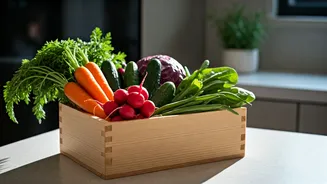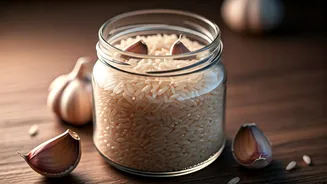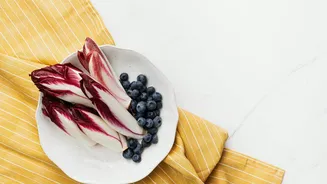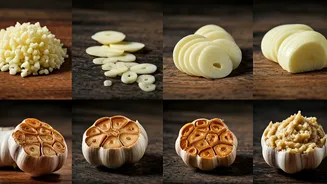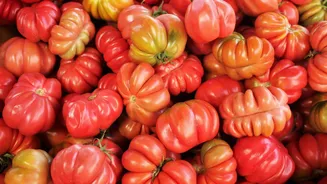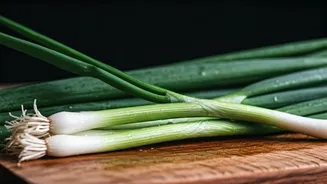Preparation is Crucial
The cornerstone of preserving vegetables lies in careful preparation, a principle deeply rooted in Japanese culinary practices. Before storing any vegetable,
take the time to inspect it thoroughly, removing any damaged or decaying parts. Then, gently clean the produce, but avoid washing them excessively unless necessary. This proactive step helps eliminate dirt and microorganisms that can expedite spoilage. For leafy greens, consider washing them right before use, as excess moisture can accelerate wilting. Proper preparation also includes trimming or cutting vegetables as needed, but remember to keep the stems of leafy greens intact to maintain freshness for a longer period. This meticulous approach sets the stage for extending the shelf life of your vegetables, ensuring they retain their flavor, color, and nutritional value for an extended duration.
Control Humidity Levels
Maintaining the ideal humidity balance is a key element in Japanese vegetable storage. Vegetables thrive in a humid environment, but excess moisture can lead to faster decay. A simple method to achieve the right balance is to store vegetables in the crisper drawer of your refrigerator, which is specifically designed to regulate humidity. Line the drawer with a clean, dry cloth or paper towel to absorb excess moisture. For vegetables that require even more humidity, such as leafy greens, wrap them loosely in a damp cotton cloth or place them in a breathable container. This helps to create a microclimate that keeps the vegetables crisp without causing them to become soggy. Regularly check the cloth or paper towel and replace it if it becomes overly wet, ensuring that the humidity level remains optimized for longevity.
Embrace Natural Wrapping
Japanese storage practices often favor natural wrapping methods over plastic bags. Instead of using plastic, which can trap moisture and promote spoilage, opt for materials like cotton cloths or beeswax wraps. These materials allow the vegetables to breathe while protecting them from external factors. For instance, leafy greens can be wrapped in a slightly damp cotton cloth, which helps retain moisture while preventing wilting. Root vegetables can be stored in a dry cloth to prevent them from drying out. Another effective technique involves using reusable beeswax wraps, which are naturally antibacterial and mold-resistant. These wraps conform to the shape of the vegetables and create an airtight seal, further extending their freshness. By choosing natural wrapping, you're not only preserving your vegetables but also contributing to an eco-friendly and sustainable lifestyle.
Strategic Fridge Placement
The placement of vegetables within the refrigerator significantly impacts their longevity. Japanese methods advise against storing certain vegetables in the coldest parts of the fridge, as this can cause them to freeze and lose their texture. Instead, it is recommended to keep them in the crisper drawer, which provides a more stable temperature and humidity level. Some vegetables, such as tomatoes and potatoes, are best stored outside the refrigerator in a cool, dark place. The ideal location is the lower shelves of the fridge, as this area tends to be less cold than the upper shelves. Ensure adequate air circulation around the vegetables to prevent condensation and promote freshness. Grouping similar vegetables together also aids in organization and helps in monitoring their condition, allowing for timely consumption and reducing wastage.
Vegetables in Fridge
Not all vegetables benefit from refrigeration. Certain vegetables thrive in the cool, controlled environment of the fridge, extending their shelf life for weeks. Leafy greens like spinach, lettuce, and kale can stay fresh for longer when stored in the crisper drawer with a damp cloth or paper towel. Broccoli, cauliflower, and carrots also benefit from refrigeration, as it slows down the process of wilting and decay. These vegetables should be properly cleaned, trimmed, and wrapped before being placed in the fridge. Herbs such as parsley, cilantro, and mint can be kept fresh by placing their stems in a glass of water and loosely covering them with a plastic bag or wrap. This approach ensures that the vegetables maintain their crispness, flavor, and nutritional value until they are ready to be used. Strategic fridge storage keeps vegetables in peak condition.
Vegetables Out of Fridge
Some vegetables fare better outside the refrigerator. Tomatoes, for instance, should be stored at room temperature to preserve their flavor and texture. Refrigeration can make them mealy and less flavorful. Potatoes and onions should be kept in a cool, dark, and well-ventilated place, away from direct sunlight. This prevents them from sprouting or deteriorating. Garlic also prefers a cool, dry environment, preferably in a mesh bag to promote air circulation. Avocados should be left at room temperature to ripen before refrigeration. Sweet potatoes and winter squash can also be stored in a cool, dry place. By storing certain vegetables outside the fridge, you can optimize their freshness and prevent unwanted textural changes or flavor alterations. This helps extend their usability and reduces food waste, making your storage methods even more sustainable.
Keep Stems Intact
An often-overlooked secret to extending the life of leafy green vegetables is preserving their stems. By keeping the stems intact, you help the leaves stay hydrated and crisp. When storing greens like lettuce, spinach, and kale, avoid cutting the stems. Instead, wash the leaves, gently dry them, and then wrap them in a slightly damp cotton cloth or place them in a breathable container with a paper towel to absorb excess moisture. The stems act as a natural source of hydration, drawing water to the leaves and preventing them from wilting too quickly. This simple yet effective technique ensures your greens remain fresh and retain their vibrant color and flavor for an extended period. It underscores the Japanese focus on minimizing food waste and maximizing the life of every part of the vegetable.
Check Regularly
Regular monitoring is essential for successful vegetable storage. Check your stored vegetables every few days, looking for any signs of spoilage, such as wilting, discoloration, or mold. This proactive approach helps you identify and address any potential issues early on, preventing the spoilage from spreading to other vegetables. Remove any vegetables that show signs of deterioration immediately. If you notice any condensation, change the cloth or paper towel in the crisper drawer to maintain optimal humidity levels. Rotate your vegetable stock, using older items first to minimize waste. This consistent attention ensures you are eating fresh, tasty produce and also helps you identify any storage adjustments that may be needed to optimize the freshness and extend the lifespan of your vegetables for the longest period possible, contributing to your goal of a zero-waste kitchen.
